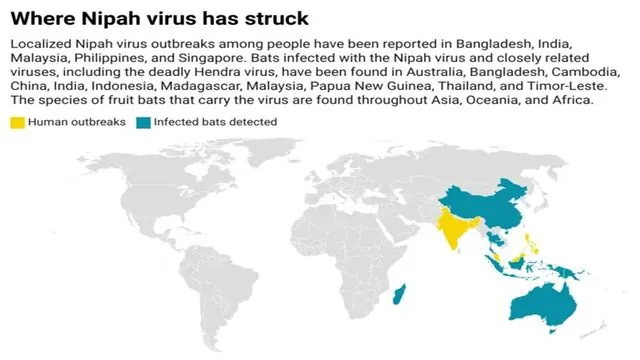
Groundbreaking Research Maps Nipah Virus Component: A Step Towards Life-Saving Treatments!
2025-01-21
Author: Siti
Groundbreaking Research Maps Nipah Virus Component: A Step Towards Life-Saving Treatments!
In a significant advance in viral research, scientists from Harvard Medical School and Boston University Chobanian & Avedisian School of Medicine have successfully mapped a critical component of the Nipah virus for the very first time. This highly lethal virus, transmitted primarily through fruit bats, has been responsible for human outbreaks nearly every year since its emergence in 1999, raising serious concerns in the realm of public health.
This study, published on January 20 in the renowned journal Cell, is a pivotal step towards the development of much-needed medical interventions, as there are currently no vaccines available to prevent or treat Nipah virus infections, aside from supportive care. Given that Nipah virus can lead to human-to-human transmission through respiratory droplets, researchers are rightfully cautious. The World Health Organization has marked Nipah virus as a priority pathogen due to its potential to cause significant outbreaks.
Nipah virus poses a terrifying pandemic potential; researchers warn that even individuals with mild, non-specific symptoms can still spread the virus. The severity of infections can lead to critical respiratory issues and encephalitis, with mortality rates fluctuating between 40 to 75 percent, depending on the outbreak—a shocking comparison to the Ebola virus, which has an average death rate of 50 percent.
The recent study highlighted the viral polymerase complex, a collection of proteins essential for the virus's ability to replicate its genetic material and infect host cells. By obtaining a three-dimensional structure of this polymerase, scientists have illuminated vital insights into how the Nipah virus reproduces and spreads within its hosts. Understanding the intricacies of this viral machinery is essential for devising targeted therapies.
Co-author Rachel Fearns emphasized the groundbreaking nature of this research, stating, 'Identifying how the polymerase is regulated to switch on and switch off the different enzymatic activities that are required for viral replication would be game-changing.' This newfound structural understanding lays the groundwork for potential treatments targeting the Nipah virus.
The scientists employed sophisticated methods, including cryo-electron microscopy, to visualize the enzyme on a molecular level and conducted simulations to explore structural alterations that might enhance drug interactions. Notably, there is a promising drug candidate from Georgia State University that shows efficacy against viruses related to Nipah but does not act on Nipah itself. This study highlighted the need for further adaptations to enhance the drug's effectiveness against Nipah.
As the researchers seek to unravel the complexities of the Nipah virus polymerase, they aim not only to inspire further investigation but also to expedite the development of new antiviral therapies. Co-first author Heesu Kim noted, 'Our study provides critical insights that could inform the development of broad-spectrum antivirals.'
The potential implications of this research could be lifesaving, providing an urgent framework for developing effective treatments against a virus that remains largely unchecked in the global health arena. The world waits with bated breath for further advances in the fight against the Nipah virus—a pathogen that could threaten millions if left unaddressed.
This breakthrough not only sheds light on a mysterious and deadly virus but also emphasizes the need for continuous investment in viral research that can protect public health.




 Brasil (PT)
Brasil (PT)
 Canada (EN)
Canada (EN)
 Chile (ES)
Chile (ES)
 Česko (CS)
Česko (CS)
 대한민국 (KO)
대한민국 (KO)
 España (ES)
España (ES)
 France (FR)
France (FR)
 Hong Kong (EN)
Hong Kong (EN)
 Italia (IT)
Italia (IT)
 日本 (JA)
日本 (JA)
 Magyarország (HU)
Magyarország (HU)
 Norge (NO)
Norge (NO)
 Polska (PL)
Polska (PL)
 Schweiz (DE)
Schweiz (DE)
 Singapore (EN)
Singapore (EN)
 Sverige (SV)
Sverige (SV)
 Suomi (FI)
Suomi (FI)
 Türkiye (TR)
Türkiye (TR)
 الإمارات العربية المتحدة (AR)
الإمارات العربية المتحدة (AR)